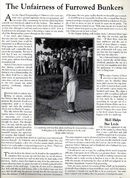Rackham Gets Historic District Status
/Reader Smitty shares this Naomi Patton story on the Huntington Woods City Commission approving a proposal to designate the Donald Ross designed Rackham Golf Course a historic district.
Huntington Woods residents and Rackham supporters applauded the vote, but they should expect a legal challenge from the private developer that plans to purchase the property.This is an interesting bit from Jennifer Chambers' Detroit News story:
Arthur Siegal, attorney for Premium Golf LLC, called the vote "politics at work," and said, "The main event is the litigation."
The 123-acre course, designed by Donald Ross, is one of the earliest integrated golf courses in America, starting from the early part of the 20th century. Its clubhouse, an Arts and Crafts structure with a heavy Prairie and Romanesque revival influence, is a 1924 state-of-the-art building with a tile roof and a long, sweeping veranda with Pewabic tile.
















